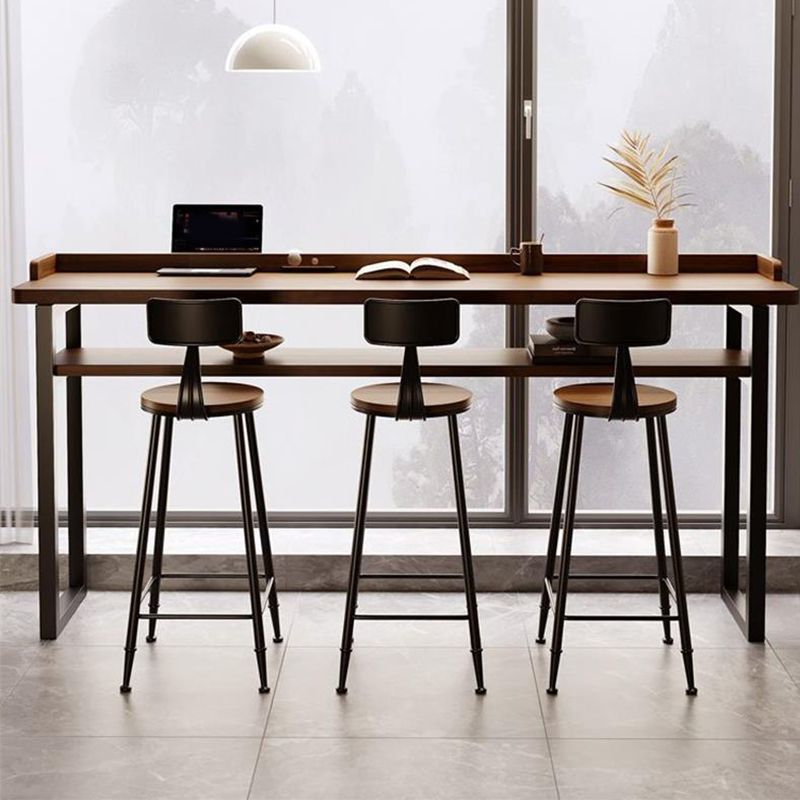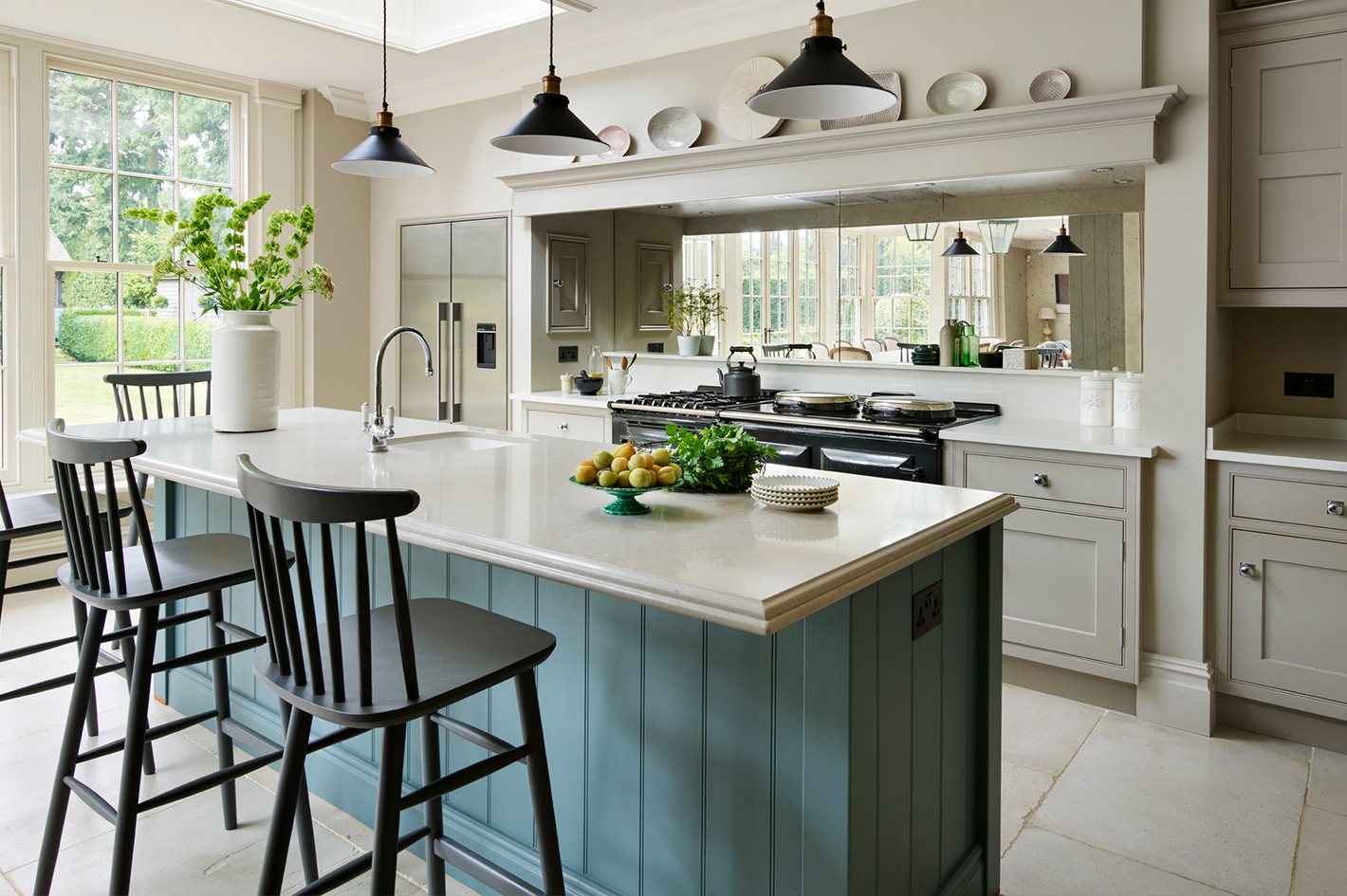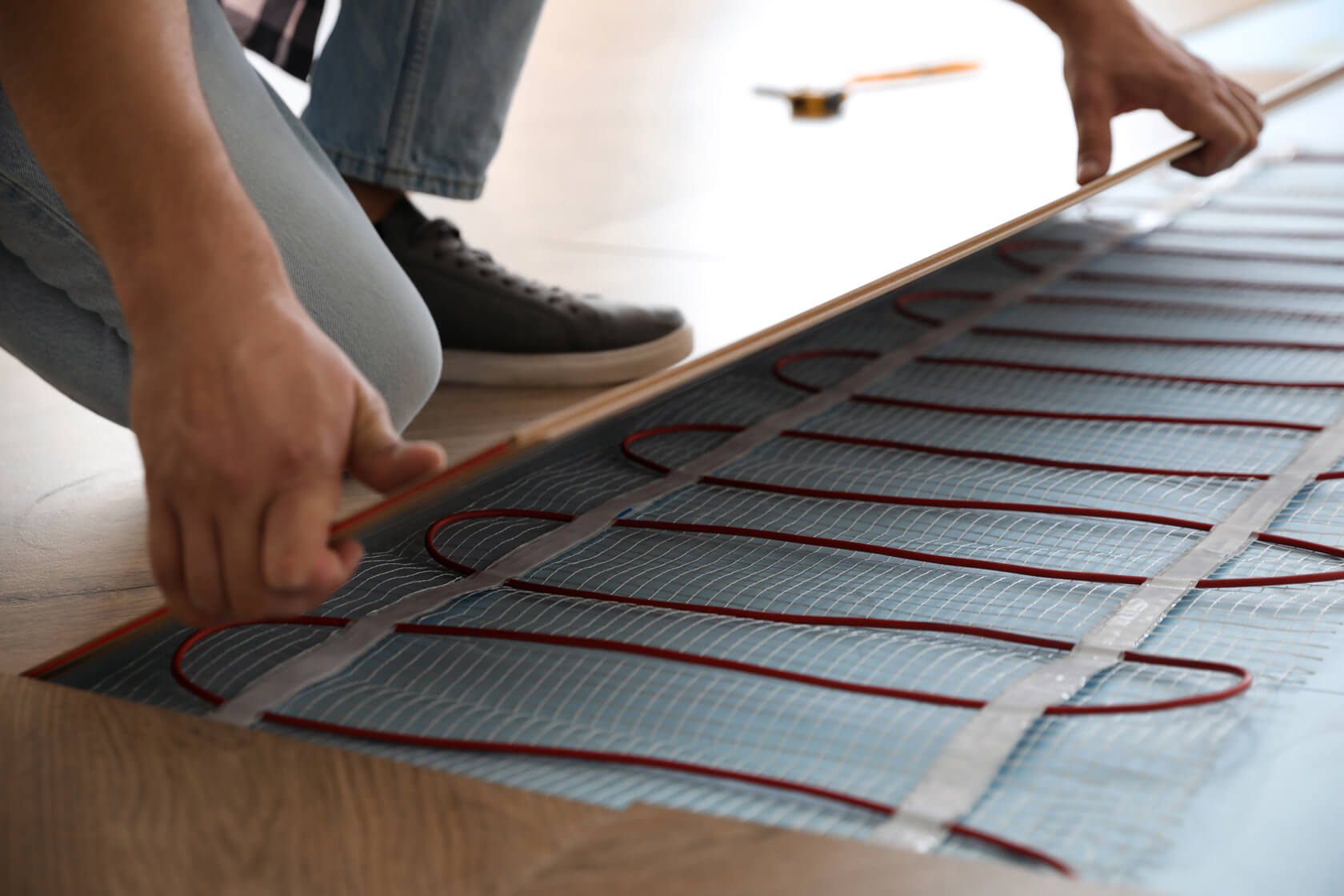The best-selling features
The best-selling features
Like most areas in life, the features home buyers most desire are subject to changing fashion
and priorities. During the pandemic, everyone wanted bigger homes and more outside space
and the most desirable features of all were homes offices and garden rooms.
Now we are all moving back into our cities, the home office is not being used quite as much as it once
was and those garden rooms that we lusted after that we often turned into gyms are no longer the
envy of our friends because exercising on your own gets boring!
So what are our priorities now?
Research shows that there are currently three key features when it comes to selling your home and
these are:
A breakfast bar – just as it sounds, it is a casual spot where you can eat breakfast. It is somewhere
between a large shelf and a kitchen island and will often be found secured to a wall. Because it adds
another distinct area, it is part of the ‘broken plan living’ trend and is especially useful in smaller
kitchens where it will add extra eating or prep space. And, best of all, it won’t cost you a fortune. You
can even build your own using a large pre-made shelf from your local DIY store. And research shows
nearly 14% of homes that have recently sold have one.
A high EPC rating – the combination of high energy prices and an ever more environmentally
conscious public have meant a home’s energy performance is becoming increasingly important. And,
with around 20% of the UK’s emissions coming from our homes, the Government is pushing hard to
get our housing stock to net zero and that may mean the legally required improvements that are
coming for the lettings industry will soon be applied to normal homes too.
The surprise is that the data shows that EPC ratings are in second place as a desirable feature to
breakfast bars, with just under 13% of recently sold homes having an EPC rating of C or above.
A kitchen island – in third place, it’s back to the kitchen and the ever-popular island. It is the sociable
centre of the kitchen and that may explain its resurgence in the best feature rankings after the
isolation of the pandemic era came to an end. It needs a decent-sized kitchen/home, so is something
of a luxury item for many. If you’ve got the space, it’s easy to see why they are so popular, as they can
house lots of extra cupboards and a huge amount of extra workspace. They also tend to be visually
appealing, too. Islands feature in 12.6% of successful sales.
The also-rans include freestanding baths at 11.1%, doer-uppers at 10.4%, wooden beams came in at
9.7%, dressing rooms at 9.5% and high ceilings at 9.2%.
Some of the items at the opposite end of the scale were pools at 5.6% and, as we referred to earlier,
large gardens are clearly out of fashion at 7.1%.
But remember, if you are selling your home, just try and make the most of what you’ve got. It’s more
important to make it sparkle rather than going to the time and expense of squeezing an island into a
kitchen that is too small, as it will only make it look cramped and reduce its desirability.
Breakfast bar image courtesy of Litfad
Scandinavian Bar Table
www.litfad.com
What makes us move?
What makes us move?
Moving house is a major upheaval. Most of us do it around 3 or 4 times in our
lives, or every 5 to 7 years. Around a million households moved home last
year, so what is it that triggers this desire to move on?
1. More space/growing family: There are not many who don't want a bit more
space. The decision to upsize can sometimes be provoked by visits to friends' and
familys more spacious homes, but the most common reason is a new baby. And it
doesnt just end there - as the kids get older, they take up even more space. When
you think there were 598,400 births in 2023 in England and Wales (source: ONS) -
there are plenty of reasons to move.
2. Being closer to family: Most of us like to be near our families, especially when
we start one of our own or our parents need some help as they get older and, as a
bonus, it can help to reduce the childcare bill. The truth is that not many of us have
wandered far from the family home in the first place - according to a recent survey -
typically, we only travel 40 miles between each move and rarely end up more than
70 miles from our place of birth.
3. School catchment area/empty nest for parents: Living in the catchment area of
good primary schools is essential and then, when the children get closer to
secondary school age, they may have to move again. 15% of parents with children
aged four to 18 claim to have moved house for this reason (source: Rightmove),
although the real figure may be much higher. And when its all over and the children
leave home, it can be the catalyst for another move, as both the need for space and
a home in an expensive catchment area are no longer there.
4. Change of job or remote work: If the perfect job comes up in another town, it
may be necessary to move. However, with the rise of remote work since the
pandemic, many are now moving for lifestyle reasons rather than job proximity.
This shift has led to increased interest in rural and suburban areas, as city-centre
proximity becomes less crucial for many workers.
5. Bored/itchy feet: A recent survey discovered that, typically, we get bored of our
properties after a period of six years and eight months. The younger you are, the
sooner you start to get itchy feet, with 25-34 year olds starting to think about moving
on after three years and nine months, whereas those over 55 don;t do so for eight
years and six months. The survey also found that 65% of all home moves were
initiated by females, because they had become dissatisfied by their current homes.
6. Divorce/separation or a new relationship: Divorce is another very common
reason for selling a house. The latest figures from the ONS show there were 80,057
divorces in England and Wales in 2022 (the last year for which complete data is
available). On the flip side, there were 246,897 marriages, but neither figure takes
into account any newly cohabiting or separating couples.
7. Downsizing/release equity: People often downsize in order to cut down on their
outgoings or release capital. Because pensions and savings are producing such low
returns, the vast majority of retirees are using the equity tied up in their home to help
fund their retirement. According to a study, 1.5 million retirees are planning to
downsize over the next five years, which would equate to 25% of all house sales.
8. Death: Its not a happy thought, but 598,000 people died in England and Wales in
2023 (source: ONS). Not all of them were homeowners and many would have been
survived by their partners, but even so, each year it results in a substantial number
of properties being put on the market.
Housing market on the move again
Housing market on the move again
The short hiatus caused by the election is now over and the various indices are
reporting house prices are growing once more and a clear trend is emerging.
Nationwide’s data shows the average price rose by 0.3% in July, with the annual rate of
growth going from 1.5% to 2.1% in July, which is its fastest pace since December 2022.
Halifax had month-on-month growth of 0.8%. Their annual growth was the highest since the
start of the year at 2.3%.
The cut in the Bank of England’s base rate came too late for it to have any discernible effect
on any of the indices’ current figures.
Both Halifax and Nationwide though have since cautioned that despite the cut, borrowing
costs remain high and house price growth will continue to be subdued while affordability
constraints remain.
Amanda Bryden, Head of Mortgages, Halifax, said:
“Last week’s Bank of England’s Base Rate cut, which follows recent reductions in mortgage
rates, is encouraging for those looking to remortgage, purchase a first home or move along
the housing ladder. However, affordability constraints and the lack of available properties
continue to pose challenges for prospective homeowners.”
And Robert Gardner, Nationwide's Chief Economist, said:
“Investors expect Bank Rate to be lowered modestly in the years ahead, which, if correct,
will help to bring down borrowing costs. However, the impact is likely to be fairly modest as
the swap rates which underpin fixed-rate mortgage pricing already embody expectations that
interest rates will decline in the years ahead.”
Rightmove’s index was the only one to report a fall (-0.4%), although their index is based on
asking prices which normally fall over the quieter summer months as sellers chase fewer
buyers. The price data then won’t appear in the other indexes for several months until those
properties are actually sold.
HOUSE PRICES AND STATISTICS
There were steady rises in July and annual growth is slowly creeping up.
Nationwide: July: Avge. price £266,334. Monthly change +0.3%. Annual change +2.1%
Halifax: July. Avge. price £291,268. Monthly change +0.8%. Annual change +2.3%
Land Registry: May: Avge. price £285,201. Monthly change +1.2%. Annual change +2.2%
Zoopla: June: Avge. price £265,600 . Annual change 0.1%
Rightmove:July: Avge. price £373,493. Monthly change -0.4%. Annual change +0.4%
(asking prices on Rightmove)
BUY-TO-LET
Although rents continue to rise, there has been a sharp slowdown in London. The average
was up by 0.7% to £1308 in July, which is an annual rise of 5.2%. In London, falls that
started in late spring are continuing. The Capital’s rents were down by 0.1% to £2,101 and
annually they were down by 0.4%.
The falls though were far more pronounced in central areas, such as Westminster (-4.8%),
Tower Hamlets (6.7%) and Wandsworth (-11.2%). In contrast, in Bromley, rents were up
6.4% and by 10.5% in Redbridge and Waltham Forest.
In other news, the looming Renter’s Reform Bill has led to a lot of speculation in the media
that there could be a mass exodus of landlords. A recent report from RICS, however, shows
although instructions to their members from Landlords had fallen, the reduction was more of
a trickle than a torrent and nowhere near the numbers seen 12 months previously.
Capital Gains
During the pandemic, the flight to the country - ‘The Race for Space’ - was never far from the headlines. It’s not surprising, at the time we were all either working remotely or had been furloughed. It meant we were spending almost all of our time in our homes and those homes, especially flats with no outside spaces, were beginning to feel somewhat claustrophobic. And, with the city’s bright lights dimmed and the commute a fading memory, there were few compelling reasons to stay. It led to significant numbers deciding they wanted to get away from the crowds and their cramped homes and move somewhere new, somewhere where there was more space and easier access to nature. According to Rightmove, at ‘The Race for Space’s’ peak in August 2021 as many as 46% of Londoners were considering abandoning the capital. The trend continued, even after the lockdowns had come to an end.
We may have all gone back to work, but many of us were still able to do so from home. The number of Londoners planning to remain in the capital for their next move is now back to the kinds of levels we used to see before the onset of the pandemic. The numbers looking to move out have now dropped from 46% to 32%. And, with the pressure to go back to the office growing by the day, that figure is likely to fall further. Transport for London stats show that commuter numbers have been increasing every year since their low point of 1.29bn journeys in 2020-21 and are predicted to reach 3.5bn in 2023-24. That is still, though, nearly 0.5bn below their pre-pandemic levels. As a result, there has been a positive start to the year in the capital’s housing market, especially when compared to the more subdued spring of 2023.
The number of homes for sale is up 11%, while the number of sales agreed has grown by 10%. Homes are also selling more quickly. The average number of days on the market is currently a day less at 63 than the national average of 64 days. Traditionally, it takes longer for homes to find buyers in the capital than in the rest of the country. Since 2017, London’s time-to-sell average has been faster than the national figure in only 6 out of 85 months.
London’s house prices rose by an impressive 1.4% last month bringing the average price to £696,120 - thats a rise of 2.8% on an annual basis. Some boroughs, though, have seen far larger rises than others. Some of the biggest are occurring in Westminster, whose market had been particularly badly hit by the pandemic, with average prices going up by 9.2% over the last year. Hammersmith and Fulham have also seen significant gains at 8.1%. Some of the more suburban areas, in contrast, have seen the biggest falls, such as Redbridge and Bexley (both down by 1.6%), Ealing (down 1.4%) and Harrow (down 1.2%). The return to the capital is also having a profound effect on rental prices. they started climbing sometime in advance of house prices, as the rental sector is more mobile and tends to react to changes far faster. London’s rental rises have already peaked back in September 2022, when they were going up by an astonishing 16.1% per annum. Although those meteoric rises have since slowed, rents still went up by 5.3% over the last year and demand remains so high that tenants are facing fierce competition to secure a new home, with an average of 9 people vying for each available property.
Selling properties Spring
The long nights are finally coming to an end and spring is on its way. It’s one of the busiest times of the year in the housing market and one of the best times to sell your home. However, winter takes a heavy toll on properties and if you want to get the best price in what is a competitive market, it’s best to try and make your place look its absolute sparkling best.
To do that, your checklist should include: the garden – front and back: windows and window frames: doors and door furniture: outside lighting: sheds and greenhouses and any exterior paintwork.
The garden is one of the bigger jobs, so let’s start with that. It may all look a bit daunting at first, but for some instant satisfaction, just have a good tidy-up. Start by sweeping up any lingering autumn leaves, paying special attention to any paths and driveways, then cut away any dead plant matter and give things like roses, hedges and perennials a quick, neatening trim.
If you need to brighten things up, there are a lot more options than you might realise. And, if you buy crocuses and daffodils in pots, you can take them with you when you move. There are also winter flowering pansies, or you could consider Forsythias and primulas to provide some high-impact spring flowers.
Pressure washing your patio is another quick win. If you don’t have a pressure washer, you can always hire one from The Library of Things for just £17.50 a day. It can make a big difference, as patios often get covered in green and black algae over winter. Garden furniture will also need a good scrub down. And don’t forget the barbecue, especially if it never got a clean after its last outing!
The lawn is another important area. Since grass grows throughout the year, it’s probably looking pretty scruffy right now. It’s amazing how much better it’ll look when it’s all neatly trimmed. Make sure you wait for a dry day, though, and cut it on a slightly higher setting than normal. If you give it a bit of a feed and weed at the same time, the nitrogen boost should ensure it goes a nice, tempting green.
It's also worth taking a long hard look at the front of your house and try and imagine how a buyer might see it. Does it have kerb appeal? Or is it all looking a bit scruffy? Be honest because it’s what sets the tone for the entire viewing and so you need to get it right. Trim those hedges, weed those paths and pressure wash the steps. And how about the front door? Is the paintwork sharp and shiny or cracking and peeling? Is the door furniture rusting and tarnished or all new and sparkly? Is there a battery in the doorbell and is the porch light working? If your house is rendered, repair any cracks and repaint if required.
Windows have an affect on both the internal and the external spaces. At this time of year, they are often filthy, which not only looks unattractive, it also cuts down on the light coming into the inside spaces. Give them a good clean or get in a window cleaner to do it for you. At the same time, you could ask them to clean any glass on your sheds and greenhouses. If the window frames are covered in cracking paint, you’ll need to repaint them and make sure you replace any broken panes and all the windows are opening smoothly.
Garden lighting (not solar stuff) is one of those areas that can often get neglected, so make sure it’s in good working order, or people may be suspicious of the quality of the electrics in the rest of the house.
None of this should cost much, just a little time.
People still have to move home
You’ve probably heard it a thousand times before, especially when there’s any kind of blip in the market - ‘people still have to move home, you know,’ your agent will say, but do you believe them? We thought we’d take a look at the numbers behind the statement and see if it really is true. You should know, I am not an agent, I’m a journalist, so I’ve got no axe to grind.
The most common reasons for moving home include: births, deaths, marriages, divorces and retiring/downsizing. And the most reliable place to get the relevant numbers is from the government, the ONS (Office of National Statistics) to be precise, who seem to keep a very close eye on us all.
Births:
Births are one of those things that happen regardless of the state of the economy or the housing market, or, as the cliché goes - the best laid plans. And, I know from experience, once your child has arrived, your one-bedroom flat is going to feel very small indeed. You may last a month or two, telling yourselves you’ll manage. You won’t. Then you’ll have to sell your flat and buy a small house or cottage. And when the next one arrives, you’ll have to sell that and buy a proper, family home. Births therefore create a lot of movement in the market and with around 777,000 of them every year, you’ll get an idea of the scale of it all, especially since they often generate two transactions, rather than one – ie the selling of a home AND the buying of another one.
Deaths:
Well, we all know about death and taxes and their inevitability. Death is certainly no respecter of circumstances, economic or otherwise. There were 586,334 deaths in England and Wales in 2021 (which was some way below average). Like births, they often generate more than one transaction, as the deceased’s house will be sold and the recipients of the money will often upgrade their houses for a bigger or better one.
Divorces:
Sometimes divorcing couples will sell their shared home and buy two new ones. Sometimes one person stays in the existing property and the other buys a new one and sometimes the arguments go on for so long their lawyers get all the money and they end up homeless (only joking). There were 113,505 divorces in 2021, and, if you’re interested, 11 years seems the average duration of a failed marriage.
Retiring/downsizing:
It’s very common to move home when retiring - you no longer need to worry about being near your place of work and with your nest now empty (mostly) you don’t need so much space, either. It is also a point in your life when you feel less at the mercy of the economy, so people move regardless of how it’s performing, including the housing market. Around 700,000 of us pack in full time work every year and that excludes Scotland. Again, this usually creates a double transaction – buying and selling.
Moving for a new job:
Now this is an area which tends to be more dependent on the economy, but even in a downturn, people still change jobs. Exact figures are hard to find, but the CIPD are forecasting that a whopping 6.5 million of us are planning to move jobs over the next 12 months (that's 25% up on this year). Granted, the majority won’t have to move home, but quite a few will and, at those kinds of numbers, they will form a significant proportion of active buyers and sellers.
So, there you go, indisputable proof that agents are telling the truth - there are significant numbers of buyers and sellers regardless of the state of the market.
What you need to know about ‘Right to light’
If you, like many of our customers at homesite, are planning on doing any building work on one of your properties - a new extension, or even a shed or a new garden wall - and it obstructs the light to another property, you need to know about the rules surrounding ‘Right to Light’. If you don’t, it could cost you money. ‘Right to Light’ is an area filled with misconceptions. Most people think it is all part of the planning process and only become aware of its true implications when a solicitor’s letter drops through the door in the middle of a project.
If you inadvertently infringe someone’s ‘Right to Light’, you may be forced to alter your building or pay compensation. In some extreme cases, it can even lead to an injunction on any further work. The most high profile cases have involved commercial developments. In recent times, a number of developers have been forced into hugely expensive rebuilds as a result of their failure to address the ‘Right to Light’ of nearby buildings, but even in a domestic context, infringements can have serious consequences.
People assume that ‘Right to Light’ is part of the planning process. Unfortunately, that’s not correct. Planners will sometimes consider it, but the fact is, it’s an entirely separate legal issue - ie Common Law rather than Planning Law. A planning decision has no legal standing in this area. It means that legal action can be taken even if the building work already has planning permission or is covered by permitted development rights.
Under the Prescription Act of 1832, a property owner automatically acquires the ‘Right to Light’ if the building has enjoyed the benefit of the light through defined apertures (ie windows) for an uninterrupted period of 20 years.
This does not mean that the light is entirely protected; the Act only gives you the right to a minimum level. This is measured using some fairly complex formulae, but as a rough rule of thumb, just over half the room should be lit by natural light in a domestic property and a little less in a commercial one. The planners are unlikely to have made any lighting level calculations when assessing a planning application and will probably be totally unaware if there is an infringement of the ‘Right to Light’.
So, what do you need to do if you are on either side of the fence in a dispute over light levels?
If you are the one doing the building, have a think about the likely impact before you begin work. Discuss it with your builder. Are you likely to block light to a neighbour’s window, for example? If you are, you may need some guidance from a specialist surveyor before proceeding. If you are on the receiving end and it's your light that's being reduced, you should also seek expert advice on your best course of action. Any disputes are handled by the courts and the usual outcome is a compensation payment. However, taking someone to court can be very expensive, so it is best to avoid it if you can. Instead, you should attempt to negotiate a mutually acceptable compromise.
The information we provide is our personal opinion and should not be relied upon for legal advice. Should you need legal advice or guidance please contact an appropriate professional.
Underfloor Heating
At this time of year, those kitchen and bathroom tiles are starting to feel a bit chilly and we all dream of underfloor heating and that fabulous warm feeling you get beneath your feet. And, with the rising popularity of heat pumps, underfloor heating seems to be everywhere at the moment. So, does that mean it’s now the most modern and cost-effective way to heat our homes?
Underfloor heating is no fad, it’s been around since Roman times. There are two main types - either water-based or electric. Both systems are highly space efficient, doing away with the need for conventional, wall-hung radiators and replacing them with a system that is housed underneath the floor. And, because they are not trying to transmit heat from just one or two sources (radiators), their heat is far more evenly distributed, enabling them to run at much lower temperatures than a conventional system. They work best when they are used under floor tiles, but can also be placed beneath wood or carpet, provided neither is too thick to allow the heat to pass through. It is recommended that carpet underlay should be no thicker than 1.5 tog and timber, or engineered flooring, should be under 22mm thick. Both systems claim to reduce humidity, which, in turn, reduces the presence of house mites. There is, though, often considerable disruption involved during installation, as you first need to rip out any existing flooring.
So which system is best for you and how much will it cost?
The water-based system is by far the most efficient and can provide energy savings of around 15% when compared to a conventional radiator-based system. In addition, while you are installing it, you will have to insert insulation between the floors, which will also improve the energy efficiency of the rest of the house. They are the only option if you are installing a heat pump, but will also work with an existing conventional boiler, although it will need separate controls as it takes longer to heat up and cool down than conventional radiators. One disadvantage is that its various component parts take up more space than the electric version, so they are not suitable for every type of installation but can, if needed, be fitted between the joists of a suspended wooden floor.
If you have an existing concrete floor, however, you will need to raise the floor levels to accommodate the pipes. This can cause problems with things like door and cupboard heights and is when installers often recommend you use the slimmer electrical version.
According to Checkatrade, installing water-based underfloor heating in an existing home costs £135 to £185 per m2. Electric underfloor heating is considerably cheaper at between £60 to £85 per m2, but as it costs around 3 times more to run, it is likely to increase your energy bill rather than lower it. The electric version is particularly useful in smaller areas, such as compact kitchens and bathrooms. As an added bonus, it is also very quick to install - all the heating elements are integrated into a thin mat, so there is no piping required. You simply roll it out across the floor and then cover it with either tiles or a wooden floor. It can easily be handled by a competent DIYer and then connected to the mains by a qualified electrician.









